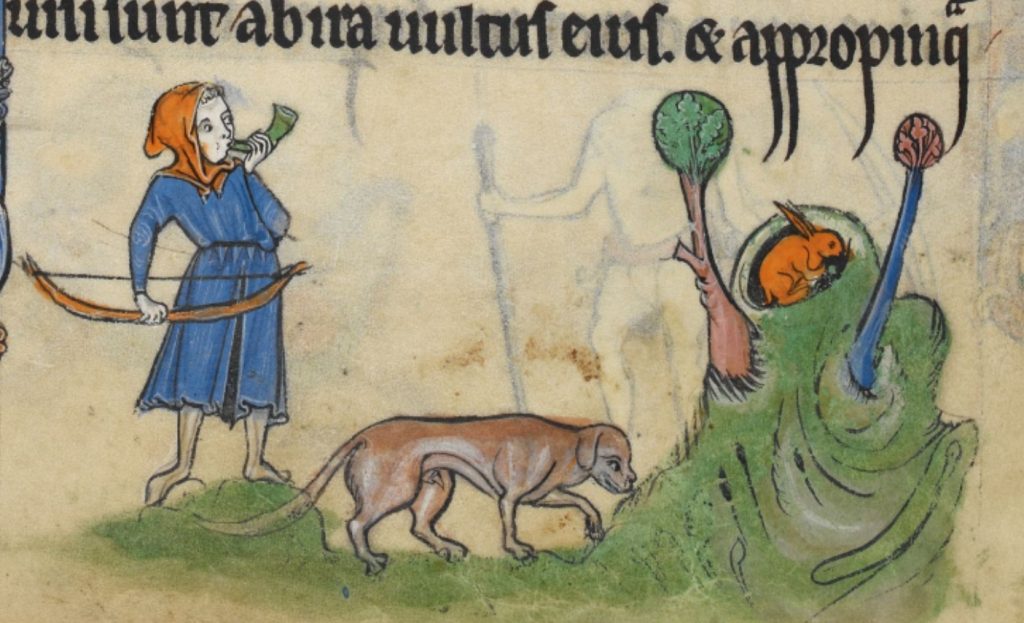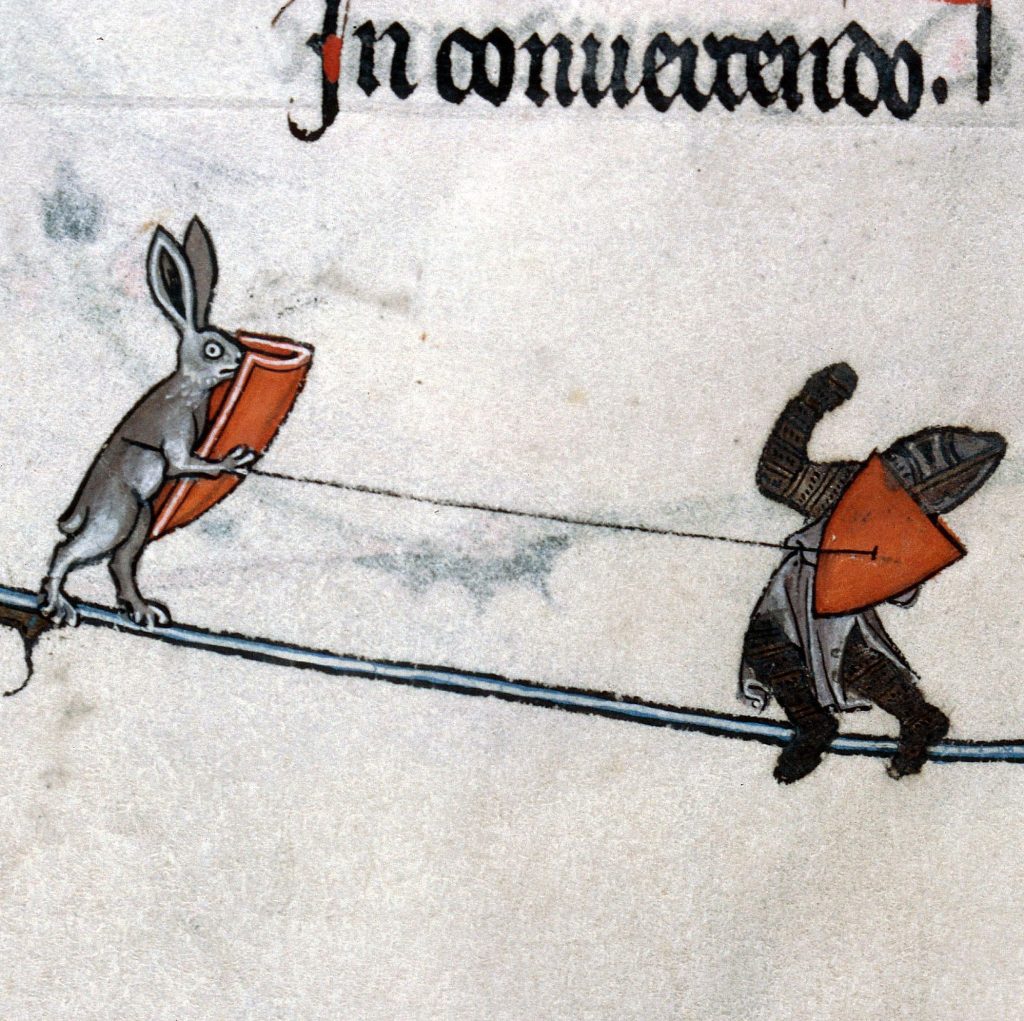Talking animals are a ubiquitous element in fables. They do not evoke wonder from human characters within the narrative, nor seem to require any explanation; this contrasts with other sorts of stories (everything from Marie de France’s Guigemar to contemporary fantasy novels) where the appearance of a talking animal signals the beginning of some rare adventure for humans. Notably, there is, however, one fable I can think of that seems to portray an animal whose ability to talk is liminal. That is, he can utter words, yet he is not really treated as a speaker. His status seems closer to that of a “real” animal who can mimic human speech, and that is in fact key to the story.
The fable in question is ascribed to Phaedrus, the author of the first extant literary fable collection. While Phaedrus wrote in the first century, his five books of fables were the basis for much of the “Romulus” tradition in prose and verse, which flourished in the Middle Ages. The aforementioned fable is called “The Traveler and the Raven” (Viator et corvus). The tale is found in “Perotti’s Appendix,” named for the Italian humanist, Niccolò Perotti (1429–80), who transmitted it; I offer a translation of it below, with the text based on Ben Edwin Perry’s edition.[1]

Quidam per agros devium carpens iter
AVE exaudivit, et moratus paululum,
adesse ut vidit nullum, corripuit gradum.
iterum salutat idem ex occulto sonus.
voce hospitali confirmatus restitit,
ut, quisquis esset, par officium reciperet.
cum circumspectans errore haesisset diu
et perdidisset tempus aliquot milium,
ostendit sese corvus et supervolans
AVE usque ingessit. tum se lusum intelligens
“At male tibi sit” inquit, “ales pessime,
qui festinantis sic detinuisti pedes.”
A certain man, taking a byway through the fields on a journey, heard “Hello!” and lingered for a moment, but when he saw that no one was there, he hastened the pace. Again, the same sound greeted him from some hidden place. He stopped, encouraged by the hospitable voice, so that whoever it was might receive an equal courtesy. When he had remained for a long time, looking around uncertainly, and lost enough time for several miles, a raven showed himself, and flying above him, incessantly repeated “Hello!” Then, realizing he had been tricked, the man said, “Damn you, wretched bird, for delaying my feet like that when I was in a hurry.”
Why did the man perceive the raven’s “hello” as a trick? (The word lusum, in line 10, comes from ludo, to play, and can suggest mockery or deception; I translated it as “tricked.”) Why did he not take this as a genuine greeting?
It seems that the man was expecting a human speaker, and was disappointed and annoyed to find out that the salutation came from a bird instead. But species difference doesn’t, in and of itself, seem like an adequate explanation, at least in the usual fable context where all sorts of creatures talk. Nor does the explanation for the man’s reaction lie in some perceived status imbalance between the two; reciprocity is expected in greetings, after all, even between parties of unequal standing, and it isn’t mockery for an inferior to greet a superior, or vice versa.
Complicating this is the fact that real birds can imitate human speech—parrots, most famously, but also corvids, including ravens. This raven repeats the same simple word, over and over, as a trained animal might. But the man simultaneously seems to impute malice or mischief to this animal and deny him as a legitimate interlocutor. The raven is capable of toying with him (and ravens have a longstanding, cross-cultural reputation for cleverness and tricks), but he is not capable of (or worthy of?) a conversation.

A traditional narrative about animal language is that it doesn’t exist—that the sounds that animals make (and this leaves aside non-aural communication, through movement, scent, etc.) are fundamentally different than human speech. Nonetheless, medieval grammarians and philosophers acknowledged that, say, a dog’s bark is not meaningless, that it might convey something of his emotional state, and that humans could pick up on this.[2] Some thinkers, too, suggested that animals can communicate with their own species in their own “language.” For example, says, Roger Bacon, hens can cluck to let their young know that food is near, or to warn them of a predator.[3]
So much for “real-life” animal language. In medieval literature, though, there may also be special talking animals (or humans gifted with a special ability to understand animals, e.g., the man who can translate between species in Culhwch and Olwen, or Canacee, with her magic ring, in Chaucer’s “Squire’s Tale”). In fables, animals’ capacity to speak is typically unremarkable, and conversations readily occur across species lines.
This fable, however, reflects none of the above scenarios. The raven doesn’t caw or croak—he says an intelligible word, in a human language, Latin. And what he says is “Ave,” a greeting. Ave is not far off from Latin avis, “bird,” although the words are etymologically unrelated; in modern Spanish and Portuguese ave means “bird”. Etymology aside, there is still the possibility of wordplay. Is the bird proclaiming what he is all along, without the man realizing it? Is that the “trick”? Was that what the bird really meant to do, or was it apt, but not necessarily done knowingly—is the raven a kind of natural sign who reiterates himself, both by appearing and by unwittingly speaking his own appearance?
In any case, the man doesn’t treat the raven’s “Ave” as a sincere speech-act from an animal who can, unsurprisingly, talk to him—he doesn’t treat it as a greeting, he treats it as a deception. (The opening moral, possibly added by Perotti, emphasizes this, declaring, “People are very often deceived by words,” Verbis saepenumero homines decipi solere).
What accounts for the man’s reaction to the raven? Fables often have talking animals, yes, but fundamentally, fables are didactic, using memorable narratives to get messages across. The raven’s real-life reputation for mischief, but above all his real-life ability to imitate speech, is what is being drawn on here. The raven in “The Traveler and the Raven” is not the genre-typical talking animal, because for him to be an actual, expected interlocutor goes against the point of the fable, which is about how words can deceive.[4] In conveying this point, “The Traveler and the Raven” both acknowledges certain animals as clever and strips a non-human character of his genre-typical linguistic capability.
Linnet Heald
PhD in Medieval Studies
University of Notre Dame
[1] Ben Edwin Perry, ed. and trans., Babrius and Phaedrus, Loeb Classical Library 436 (Cambridge: Harvard University Press, 1965), pp. 404–6.
[2] For an analysis of the shifting conceptions of the semiotics of dogs’ barking, from Aristotle to Roger Bacon, see Umberto Eco et al., “On Animal Language in the Medieval Classification of Signs,” in On the Medieval Theory of Signs, ed. Umberto Eco and Constantino Marmo (Amsterdam: Benjamins, 1989), pp. 3–41.
[3] Quoted in Eco et al., “On Animal Language,” p. 36, n. 39.
[4] Fables tend to teach the “mistrust of words,” argues Jill Mann, in From Aesop to Reynard: Beast Literature in Medieval Britain (Oxford: Oxford University Press, 2009), p. 96.









